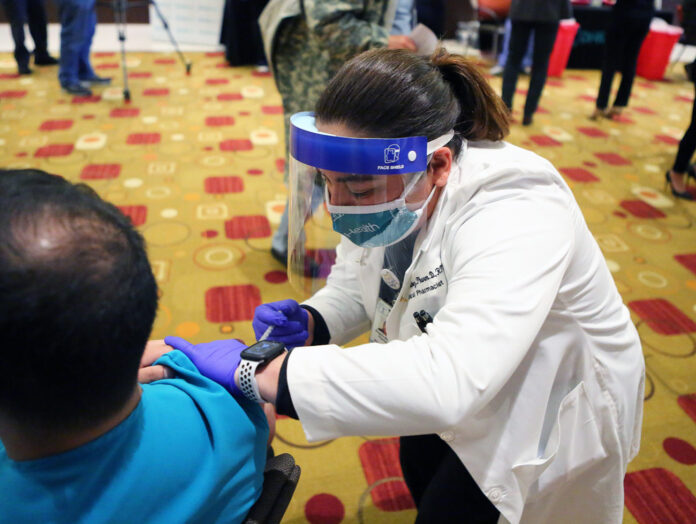Distribution of one of history’s most highly sought-after vaccines relies on an “honor system” in Texas. In the Rio Grande Valley, that system is being tested as providers face low vaccination interest in the highest priority tiers.
Nurses, doctors, home healthcare workers and residents of long-term care facilities are among the first group allowed to receive the vaccine as outlined by the state.
“There’s wiggle room and there’s some discretion,” said Dr. Robert Martinez, DHR Health chief physician executive, adding, “It’s a little loose, but it’s just a matter of who wants to take it.”
A lower-than-expected interest among those in the medical community led DHR Health — the provider that received the greatest volume of COVID-19 vaccines in the Valley — to broaden its offering starting Friday night when Starr County healthcare workers were invited to get the vaccine.
On Saturday, lines of people wrapped around the Edinburg Conference Center at Renaissance where law enforcement officers, who are not on the state’s Phase 1A tiers, received vaccines.
Inside the conference center, the hospital hosted a media appreciation luncheon. Members of the media were taken aside for a tour of the preparation of the vaccine led by Marissa Castañeda, senior executive vice president at DHR Health.
Castañeda said they’d be trying to share the next shipment of the vaccines with members of the community like the elderly, teachers and journalists, though current state guidelines do not prioritize teachers or journalists.
Castañeda later clarified she meant the community as a whole, which would include members of the media.
Over at the UTRGV campus on Saturday, the opportunity to receive the vaccine was also opened up to include people outside of the university system.
The vaccine was first offered to their staff like nurses, doctors and students who were going to the hospital. Dr. John H. Krouse, dean of the School of Medicine, said the state guidelines kept them from offering the opportunity to the school at large.
Instead, they began inviting EMTs and paramedics from the Valley. The employees tasked with registering the people taking the vaccine screened them by asking for identification, licenses or badges.
DHR Health has a similar screening process, according to Martinez.
“They have to show us credentials that they work for a particular company,” he said.
The providers’ word to adhere to the guidelines is their bond.
Douglas Loveday, a press officer with the Department of State Health Services, said, “We’re just asking our providers to use their best judgment in adhering to Phase 1A guidelines and to follow through on their agreement and commitment to become a COVID-19 vaccine provider.”
“We got accused of giving it to the public,” Martinez said. “We’re really not giving it to the public. We’re giving it to people that we’ve gone down the line.”
The vaccine’s short shelf life is behind the expanded offerings seen this weekend.
Once Pfizer BioNTech’s COVID-19 vials are thawed and the saline is added, the vaccine must be used within six hours, Krouse explained. It can be placed back in the freezer if it wasn’t diluted and must be used within five days.
“So, the goal is to get it to the most appropriate people first. If they don’t want it, they’ve gotten the chance,” Martinez said. “But, if you offer it and they don’t take it, then you got to move on to the next round.”
The state requires the providers to report any unused doses of the five in every vial. The Pfizer BioNTech vials are overfilled providing a sixth or even seventh dose. UTRGV is using the extra dose; DHR Health opted not to.
If they use the extra dose, they’re required to report it and enter the recipient into the state’s immunization system. If the dose is not used, the state does not require the provider to report its outcome.
It’s unclear if the state’s guidance is deliberately designed to give providers leeway in their discretion to administer the life-saving vaccine.
DHR Health said they will continue to work to ensure every dose is used. When they receive a second shipment, Martinez said they hope more people from the first tier are encouraged to take it.
Krouse said a member of the governor’s task force informed him the next prioritization tier will include those 65 and older, and those with significant medical illnesses.
When the next vaccines arrive, “we start from the top again,” Martinez said. “We’re going to go through that list every time we get a (batch) of vaccines.”
Monitor staff writer A. Colleen DeGuzman contributed to this report.





